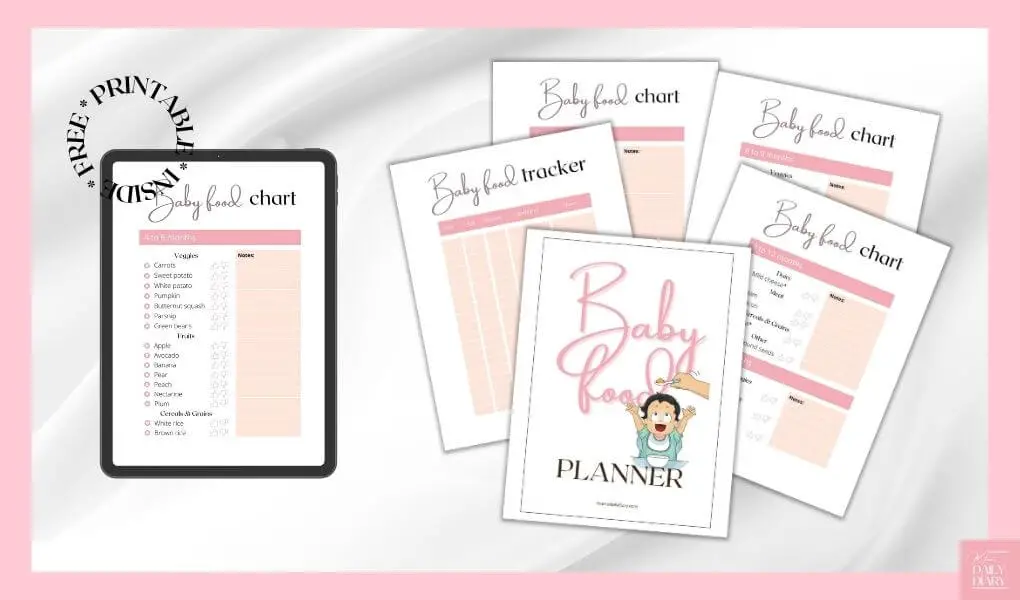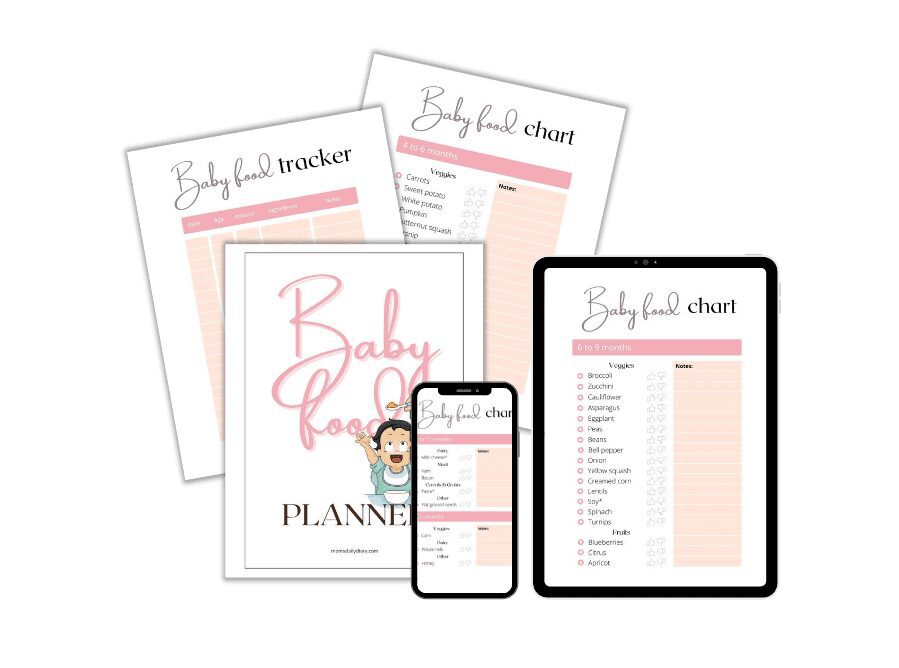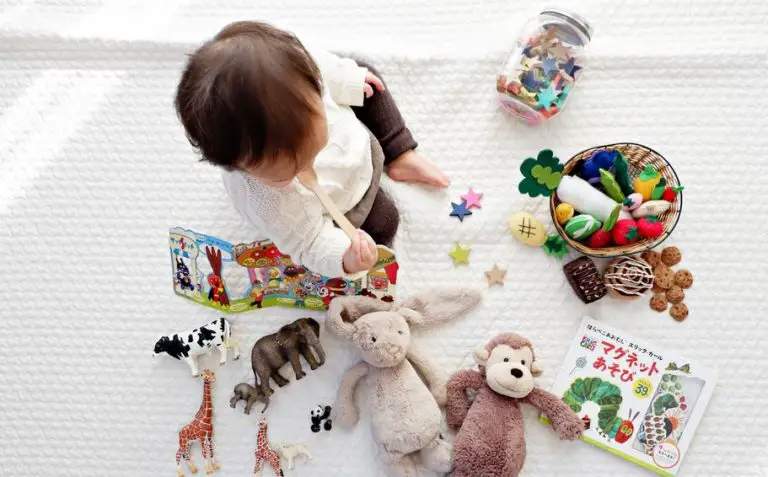Baby’s First Solid Food For The Ultimate Beginner
Offering your baby’s first solid food is a huge milestone. It goes as high as the first sound of “mama” and their first wobbly steps.
But it’s also a terrifying moment for first-time moms. What if the food is not good enough? Will I notice any reactions to the food? What if my baby chokes?
Note: This post may contain affiliate links, which means if you buy from my link I might make a small commission. This does not affect the price you pay. See the full affiliate disclosure here.
Don’t worry, I’m here to help you ease into your new normal. Here’s everything you need to know explained as simply as can be.
When do you introduce solids to your baby?
According to the World Health Organization, exclusive breastfeeding is recommended for the first 6 months of your baby’s life. But that’s only the ideal case scenario.
Sometimes, however, life gets in the way and plans change. And in some cases, your pediatrician may recommend introducing your baby’s first solid food as early as 4 months old. The two most common reasons for this include:
- Your baby is exclusively on infant formula.
- The baby suffers from severe acid reflux.
And while the main principle is all the same whether you’re starting at 4 or 6 months, there is one major difference: Forget about baby-led weaning at 4 months old.
6 Signs your baby is ready for solids
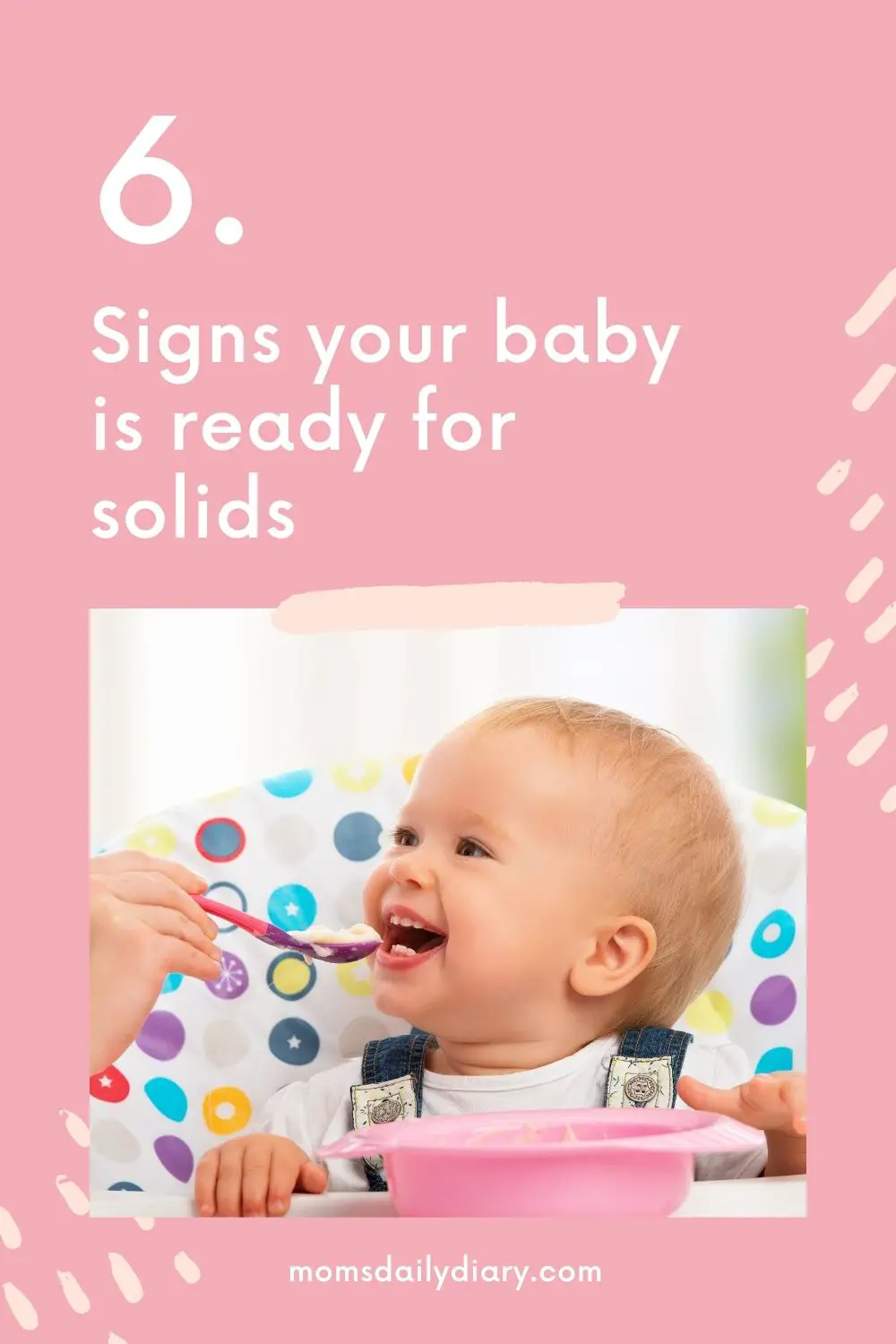
Before steaming your first carrot, you need to know that your baby’s age is not the only factor that needs to be taken into account.
Babies develop at different rates. And while they may be old enough, you need to watch for other signs as well.
- They can sit upright.
- Your baby has complete control over their head.
- The baby looks at you curiously when you’re eating.
- They open their mouth when you offer them the food.
- The tongue-thrust reflex is gone, i.e. they don’t push the food out of their mouth automatically.
- They seem hungry all the time, i.e. their milk diet doesn’t satisfy them anymore.
What is the best baby food to start with?
There are plenty of baby weaning plans available online.
But let me tell you, there is no specific order in which you need to introduce the different foods.
You need, however, to make sure that the food is appropriate for their age. In other words, their digestive system may not be ready to process all kinds of foods in the first few months.
Still, to answer the question here is a quick reference to all foods that are recommended to start weaning a baby:
Vegetables
- Carrot
- Sweet potato
- White potato
- Pumpkin
- Butternut squash
- Parsnip
- Green bean
Fruits
- Apple
- Avocado
- Banana
- Pear
- Peach
- Nectarine
- Plum
Cereals and grains
- White rice or white rice cereal
- Brown rice or brown rice cereal
Tips and tricks to introduce your baby’s first solid food
Weaning your baby can be a piece of cake if you follow a few simple principles.
Prepare your supplies
You don’t need much to start with your baby’s first solid food. Still, you may want to go and get some supplies:
- High chair. A safe, comfy and practical high chair is a must if you’re going to start feeding your infant solids. Be sure to always secure the harness and don’t take it for granted that they are not mobile enough just yet. Your baby can surprise you any day now so don’t leave them out of your sight while in the high chair.
- Baby spoon. Make sure that it’s soft and age-appropriate or your baby may reject the food just because they don’t like the spoon. A great bonus is if they are heath-sensitive, meaning they change color if the baby food is too hot.
- Bibs. Tons of them. I recommend trying the ones that cover your baby like a shirt or the silicone ones with a food pouch.
- Baby bowl. Pick a bowl with suction if you’re going to offer finger food. Otherwise, you risk having it all over the place.
- Baby food storage containers. You’ll need these if you’re preparing your own food. Make sure they’re airtight and suitable for freezer, microwave, and dishwasher (if you have one).
Keep track of everything
Keeping track of weaning your baby will help you in a lot of ways including:
- Easier communication with your pediatrician.
- Looking for possible patterns, reactions, likes, and dislikes.
- Knowing what you’ve already introduced and what you still need to add to the baby’s menu.
- Knowing when it’s time to stop substituting with breast milk or infant formula for this feed.
- Remember what you did right (and what you did wrong) when it’s time to wean your next baby if you’re planning on having more kids.
The most important metrics that you need to track are which foods you have introduced, whether your baby had any reactions to them, and whether they like them or not.
On a separate note, you would also want to track the daily amounts, the food or food combination you offered, how old was your baby when you introduced the new ingredient and any other notes that seem important at the time.
For all of the above, feel free to grab my free Baby food planner by signing up to my mailing list.
Start with a veggie
The reason many pediatricians recommend starting with a vegetable instead of fruit is pretty simple. Offer your baby something so sweet as their first solid meal and they may refuse the not so tasty veggies later on.
Offer as lunch first
When you first start introducing baby solid food, you don’t have to plan for 3 meals a day.
Instead, start with one portion of pureed food at lunch. If you start weaning at the 6-month mark or later you can also offer finger food that your little one will hold on their own.
Pick a time that is comfortable for you both and when you’re not pressured or in a hurry. It’s important to give your baby enough time to get used to the new taste.
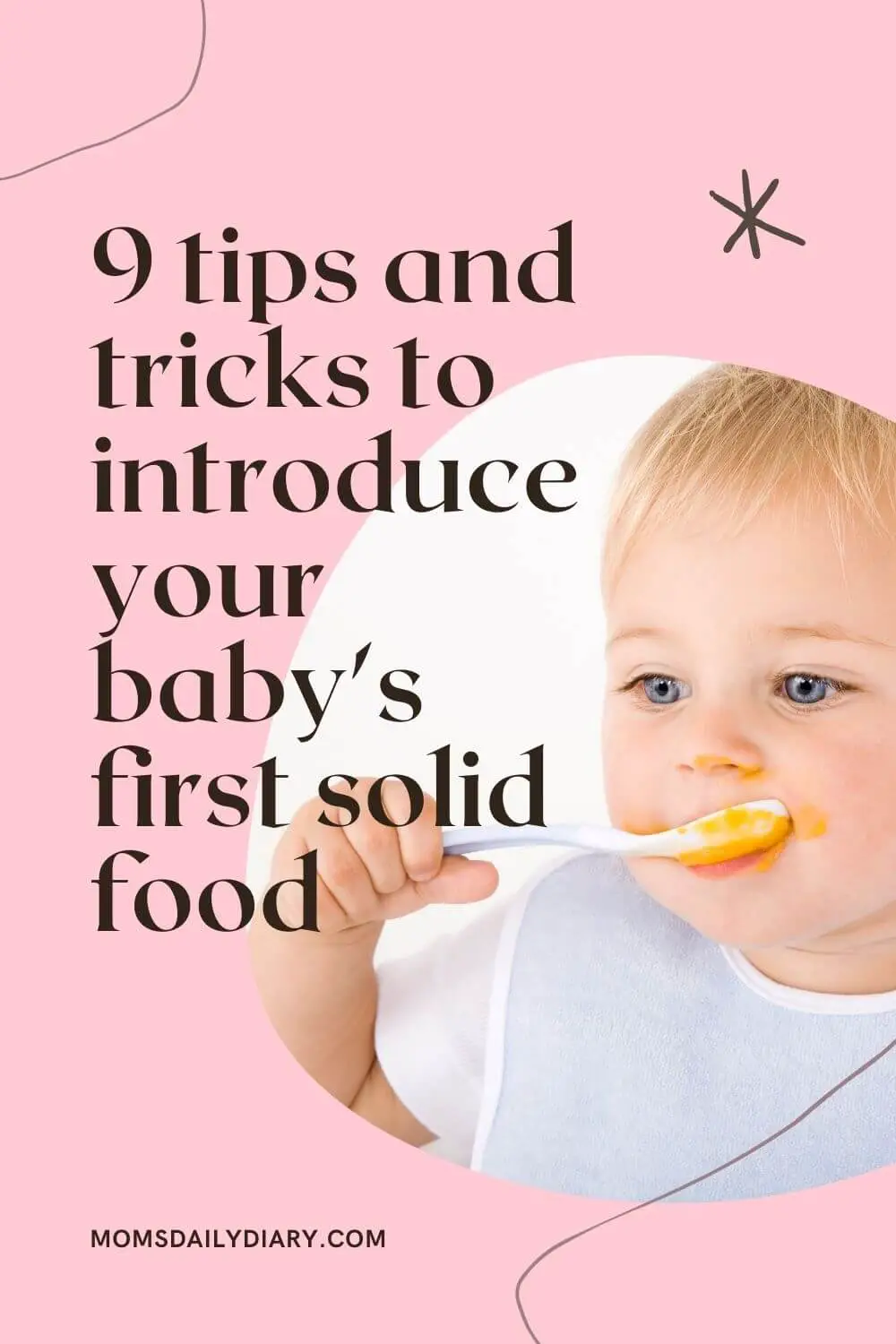
Start with a single spoon
For a few more months, your baby will still receive most of their nutrients from their milk feed. So don’t worry if they eat just a little bit. The idea is to get used to the taste.
Start the first day with a single spoon (or two if they like it so much). Double the amount on the next day. On day 3 you can offer 5 to 10 spoons depending on the likes of your baby.
After that, you’ll need to start looking for signs that they’re full. These could be
- Closing their mouth firmly
- Turning away their head
If they are not interested, try again tomorrow or next week (if it’s their very first try).
Encourage your infant to eat slowly
You know that it’s healthier to eat slowly. This applies to adults as well. So don’t rush your little one to eat it all up quickly too.
Give them time to move the food in their mouth before they swallow it so they can learn to chew.
Also, it is highly recommended that you turn off the TV and keep distractions to a minimum. Otherwise, you may get them into a really bad habit early on.
Wait for 3 to 5 days before introducing the next food
To rule out a possible food allergy, you need to offer each new food for at least 3 days before proceeding with different food.
However, this doesn’t mean that you have to offer only a single-ingredient puree.
Instead, you can play with different combinations of foods that you have already introduced and see what your little one likes.
By the way, did you know that an infant needs to try each food about 10 times before they can decide whether they like it or not?
So don’t be in a hurry to rule it out just because they spit it the first time.
Consider allergies that run in the family
While according to the American Academy of Pediatrics there is no reason to delay introducing allergens in general, for your own peace of mind check if anyone in the family has a known food allergy.
If so, your baby may be predisposed as well, so you’ll need to be careful with the following common allergenic foods and consult your baby’s healthcare provider first:
- milk
- eggs
- wheat
- fish
- shellfish
- peanuts
- tree nuts
- soybeans
Be prepared in case they start choking
During the weaning stage, you must never leave the baby alone during feeding time and immediately afterwards. If there is still food left in the baby’s mouth there is a risk they start choking.
Most of the time it’s absolutely harmless and they’ll just cough it out. In other cases, however, you may need to intervene.
I highly recommend watching a first aid for choking infants video before introducing your baby’s first solid food.
To reduce choking risk, avoid offering hard foods like apples, raw carrots, or whole nuts in the first few months.
Baby food preparation basics
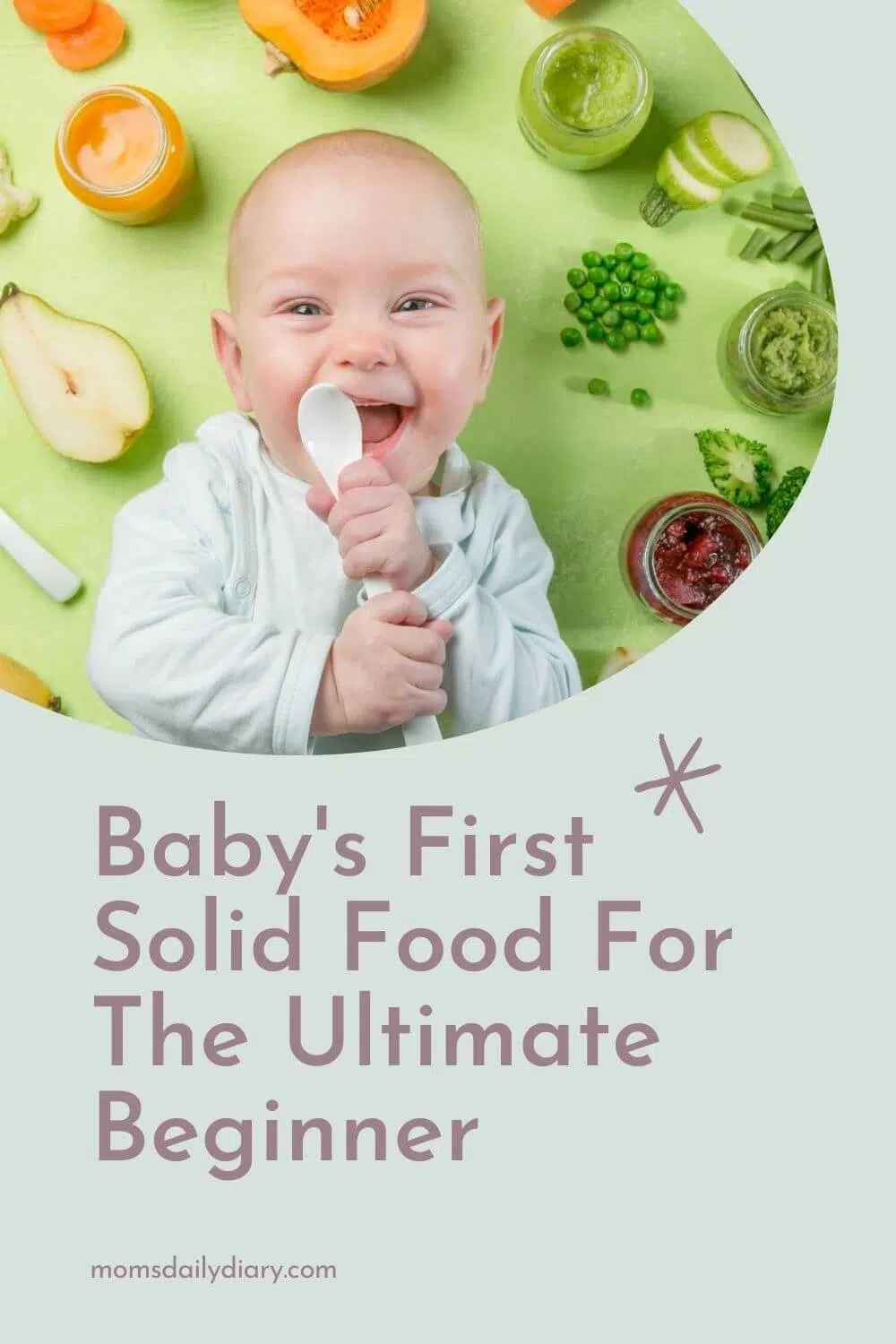
Homemade vs commercial baby food
It was once believed that homemade is the only way to offer healthy food to your baby. Nowadays, this is not exactly the case because major baby food brands are under strict regulations.
Still, if you want to create your own food, here are some tips to get you started:
- Strive for seasonal fruits and veggies. They are more likely to be natural and pesticide-free.
- Avoid buying from huge grocery stores. Unless you’re going for their bio section, their products are not the best fit for a weaning baby.
- Add some breastmilk or formula if needed. Some purees may be thicker when prepared solely. Adding some milk will help you achieve a smoother texture.
- Get some ice cube trays and freezer-friendly containers. You’ll need these to freeze the pureed food when you cook in batches.
- Pureed meat is best preserved in ice cube trays or similar silicone containers. This way you’ll have a number of single portions ready to add to your veggies.
- Do NOT add salt, sugar, or any other spices. They should be avoided for your baby’s first solid food meals.
Getting the texture right
Eating solids is a whole new skill for your infant. So you need to give them time to learn to chew.
How do you do that? By slowly updating the texture of the food you offer.
Here is how to progress with the baby food structure:
- Pureed or blended (very smooth texture)
- Mashed
- Lumpy
- Finger food
While some babies start right off with finger food (baby led weaning), others may need more time to get used to each texture before proceeding to the next one.
So watch your baby closely and let them guide you through.
Ready to start weaning? Grab your free baby food planner by subscribing to the mailing list and you’re good to go!

